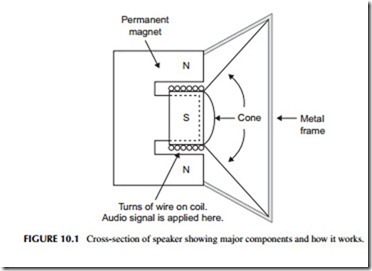INTRODUCTION
While the telephone, telegraph, and radio are generally considered the first real electronic applications, audio was certainly next. By “audio,” I mean sound: voice and music, things we can hear. Audio signals have frequencies within the range of the human ear. Over the years many electronic devices have been developed to amplify, capture, and reproduce sounds of all types. Today, like everything else in electronics, audio electronics is predominantly digital, although many analog devices and systems are still in use. This chapter is a summary of audio devices you know and use every day from stereo systems to iPods.
THE NATURE OF SOUND
Sound is just pressure waves in the air that your ear can hear. Anything that produces a noise or other disturbance produces pressure waves that travel to your ears where the sound waves are converted into signals that your brain recognizes as sound. The frequency range of these air vibrations is 20 Hz to 20 kHz. Our ears do not respond to lower or higher frequencies even though they may be present. Human hearing also varies widely due to age and health status. Age brings on hearing loss, especially of the higher frequencies.
There are four key things needed in audio electronics:
● The ability to convert sound waves into electrical signals.
● The means to convert the electrical signals into sound.
● A way to amplify the signals.
● Media to store or record the signals. This is what audio electronics is all about.
Microphones
The microphone is the transducer that converts sound waves into an analog signal. The sound waves impinge on the microphone and it causes vibrations that are translated into a signal by either capacitive element or an inductive coil. A technical discussion about microphones is way beyond the scope of this book. In any case, the resulting signal is usually very small, in the millivolt range or even microvolt range. Therefore, it must usually be amplified before it is useful. This is the function of a small-signal amplifier usually called a preamplifier. What you do with the signal after that is up to you. Typically it will be amplified further for use in a public address (PA) or other sound sys- tem. Or alternately, the voice may be recorded. Many voice signals will be used in a telephone, cordless or cellular.
Speakers
A speaker is a transducer that converts the audio signal into sound waves that you can hear. You have obviously seen a speaker, so little explanation is needed. Its main element is a paper or plastic cone that vibrates at the audio frequencies applied to it. Then it produces the sound pressure waves that our ears will hear.
Figure 10.1 shows how a speaker works. The cone is attached to a form around which a coil of wire is wound. This is the so-called voice coil. That voice coil is positioned inside a strong permanent magnet with north and
south poles. Now when you apply the audio signal to the coil, current flows and causes the coil to become an electromagnet. The electromagnet generates alternating north and south poles as the voice or music signal occurs. These magnetic fields interact with the permanent magnet, causing attraction and repulsion of the voice coil, and the cone moves. The motion of the cone accurately reproduces the original sound waves.
Speakers come in a wide range of sizes and types. Cone speakers are usu- ally called mid-range speakers in that they can reproduce most of the frequency range except for the very low and very high frequencies. Special speakers are used for those frequencies. A woofer or subwoofer is a larger speaker designed for frequencies of about 600 Hz and below. A tweeter is a special speaker optimized for the higher frequencies above 10 kHz. Special filters calledcrossover networks separate the signal into low, mid-, and high frequencies as shown in Figure 10.2.
The remainder of this chapter addresses the amplification and record- ing or storage of audio signals. Along the way, most analog audio signals are digitized. And many are also compressed to save storage space or reduce the binary data rate for transmission.
